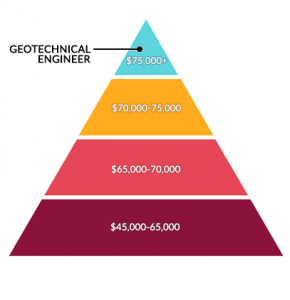Getting My Geotheta To Work
Table of ContentsGeotheta - The FactsUnknown Facts About GeothetaMore About Geotheta10 Easy Facts About Geotheta ShownGeotheta Things To Know Before You Buy

They conduct site investigations, gather examples, execute research laboratory tests, and assess information to evaluate the viability of the ground for construction projects - Consulting Engineer. Based on their searchings for, geotechnical designers provide recommendations for foundation design, incline security, preserving frameworks, and reduction of geotechnical threats. They team up with various other experts, such as designers, structural engineers, and construction groups, to ensure that geotechnical factors to consider are integrated right into the general job style and implementation
By evaluating the behavior and residential properties of dirt and rock, they can determine potential geotechnical hazards such as landslides, dirt negotiation, or slope instability. Their proficiency aids protect against failings or accidents that can jeopardize lives and property. Below are some in-depth responsibilities and responsibilities of a geotechnical designer: Site Investigation: Geotechnical designers conduct website investigations to collect data on subsurface conditions.
They translate the data to understand the residential or commercial properties and actions of the dirt and rock, including their stamina, permeability, compaction features, and groundwater conditions. Geotechnical Evaluation and Layout: Geotechnical designers assess the data accumulated throughout site investigations to evaluate the security and viability of the website for construction projects. They execute geotechnical estimations and modeling to examine elements such as bearing ability, negotiation, slope security, side earth stress, and groundwater flow.
Things about Geotheta
Foundation Style: Geotechnical designers play a vital function in designing structures that can safely sustain the designated framework. They evaluate the soil problems and tons requirements to figure out the proper foundation kind, such as superficial foundations (e.g., grounds), deep structures (e.g (https://www.tripadvisor.in/Profile/geotheta1)., heaps), or specialized techniques like dirt enhancement. They consider factors such as negotiation restrictions, bearing ability, and soil-structure interaction to create ideal structure layouts
They assess building and construction strategies, screen site activities, and conduct area examinations to validate that the style referrals are followed. If unpredicted geotechnical issues emerge, they analyze the situation and provide suggestions for removal or changes to the style. Risk Assessment and Mitigation: Geotechnical designers examine geotechnical risks and threats connected with the task website, such as landslides, liquefaction, or dirt erosion.

Partnership and Interaction: Geotechnical designers function very closely with various other professionals associated with a job, such as architects, architectural engineers, and construction teams. Reliable communication and cooperation are vital to integrate geotechnical factors to consider into the total project layout and construction procedure. Geotechnical designers supply technical expertise, response questions, and ensure that geotechnical requirements are satisfied.
The Facts About Geotheta Uncovered
Here are some types of geotechnical engineers: Foundation Engineer: Foundation engineers specialize in creating and assessing structures for frameworks. They analyze the dirt problems, lots needs, and website features to determine one of the most appropriate foundation type and design, such as shallow foundations, deep structures, or specialized techniques like heap structures.
They assess the elements influencing incline security, such as soil residential or commercial properties, groundwater conditions, and incline geometry, and create approaches to protect against incline failures and reduce risks. Quake Designer: Earthquake engineers specialize in examining and developing frameworks to endure seismic pressures. They assess the seismic danger of a site, evaluate dirt liquefaction potential, and establish seismic style criteria to make sure the security and durability of structures throughout earthquakes.
They carry out area testing, accumulate examples, and evaluate the accumulated data to characterize the dirt buildings, geologic formations, and groundwater problems at a site. Geotechnical Instrumentation Designer: Geotechnical instrumentation engineers concentrate on surveillance and measuring the behavior of soil, rock, and structures. They mount and maintain instrumentation systems that keep an eye on factors such as dirt settlement, groundwater degrees, slope motions, and architectural displacements to analyze performance and give early cautions of potential problems.
The 3-Minute Rule for Geotheta
They carry out tests such as triaxial tests, consolidation tests, straight shear tests, and permeability tests to collect information for geotechnical evaluation and layout. Geosynthetics Engineer: Geosynthetics engineers focus on the style and application of geosynthetic products, such as geotextiles, geogrids, and geomembranes. They make use of these materials to improve soil stability, strengthen inclines, provide drain options, and control disintegration.
They often tend to be investigatory people, which implies they're intellectual, introspective, and curious. They are curious, systematic, sensible, logical, and rational. Some of them are also social, indicating they're kind, generous, participating, individual, caring, practical, compassionate, tactful, and pleasant - Tailings Engineer.
In the office environment, geotechnical designers utilize specialized software application tools to execute computations, create layouts, and examine data. They prepare records, evaluation project requirements, interact with clients and team members, and coordinate job activities. The office setup provides a favorable setting for research study, analysis, and collaboration with various other experts entailed in the task.
The Definitive Guide for Geotheta
They frequently check out project websites to perform site examinations, examine geotechnical conditions, and gather information for analysis. These sees entail traveling to various locations, often in remote or challenging surfaces. Geotechnical designers may do dirt sampling, conduct examinations, and display building and construction tasks to make sure that the geotechnical aspects of the job are being implemented properly.
Geotechnical designers also function in specialized geotechnical laboratories. In these facilities, they perform experiments, perform tests on dirt and rock examples, and analyze the design homes of the products. Geotechnical research laboratory designers work thoroughly in these settings, dealing with testing devices, running instruments, and tape-recording data. They team up with various other research laboratory staff to make sure exact and dependable testing results.